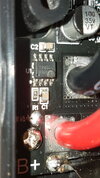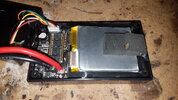SentinelAeon
Member
I would like to verify my understanding of super capacitors and i will give a practical example that i found online a few days ago. It was regarding a cheap spot welder with small lipo battery. It was said that the design is not good and it would be better to include a super capacitor to aid the small battery. So it made me think whether i understand how capacitors in combination with a battery actualy work. In the attached image there are 3 examples and i would kindly ask you to check if my understanding of it is correct. Thanks












